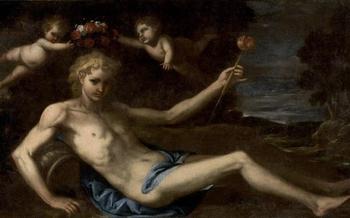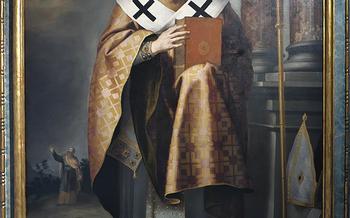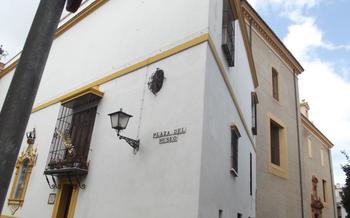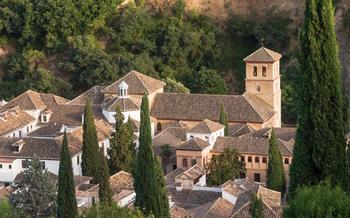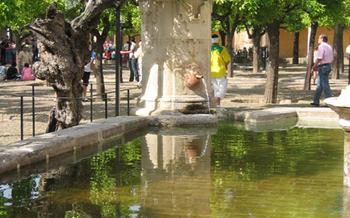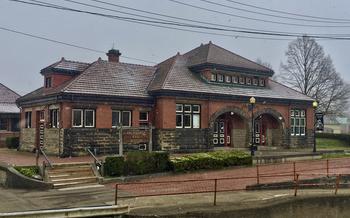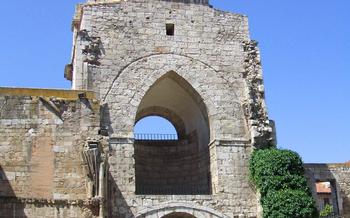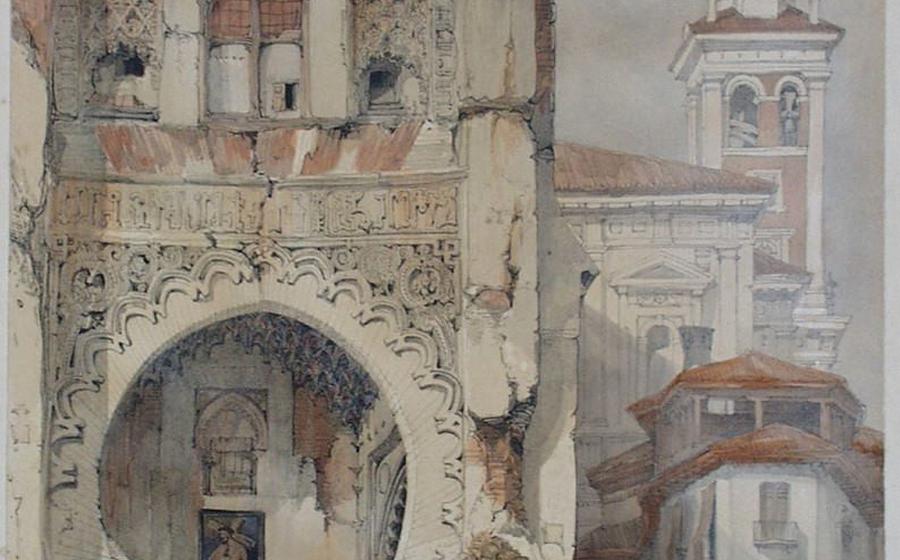
Museum of Fine Arts, Granada
- Historical Background
- Must-See Masterpieces
- Collections and Exhibitions
- Educational Programs
- Location and Accessibility
- Opening Hours and Admission
- Practical Tips for Visitors
- Hidden Gems and Lesser-Known Works
- Thematic Tours and Guided Visits
- Temporary Exhibitions and Special Events
- Interactive Displays and Multimedia Experiences
- Accessibility for Visitors with Disabilities
- Photography and Social Media
- Local Recommendations and Nearby Attractions
- Insider Tip: Seek Out the Secret Gem
Historical Background
Founded in 1839, the Museum of Fine Arts in Granada holds a significant place in the cultural landscape of the city. It houses a remarkable collection of artworks spanning from the 15th to the 20th century, showcasing the evolution of Spanish and European art. Among the prominent artists represented in the museum are Alonso Cano, Pedro de Mena, and José María Rodríguez-Acosta, whose works reflect the diverse artistic influences that have shaped Granada's rich cultural heritage. Housed in a former monastery, the building itself is a testament to the city's architectural grandeur, blending Renaissance and Baroque elements that add to the museum's historical charm.
Must-See Masterpieces
Among the many treasures housed within the Museum of Fine Arts, Granada, several masterpieces stand out as must-see attractions for art enthusiasts. One such work is "The Annunciation" by Pedro de Mena, a breathtaking sculpture that captures the moment of the angel Gabriel's visitation to the Virgin Mary. The intricate details and lifelike expressions convey a sense of divine presence and evoke a profound emotional response in viewers.
Another highlight of the collection is "The Virgin of the Tears" by Alonso Cano, a poignant painting that depicts the Virgin Mary shedding tears over the suffering of her son, Jesus Christ. The delicate brushstrokes and masterful use of light and shadow create a deeply moving and compassionate portrayal of the Virgin's sorrow.
Art lovers should not miss "The Martyrdom of Saint Cecilia" by Francisco de Goya, a powerful and dramatic painting that captures the moment of the saint's execution. Goya's unique style and expressive use of color convey the intensity of the scene, highlighting the saint's courage and resilience in the face of adversity.
These are just a few examples of the exceptional works that await visitors to the Museum of Fine Arts, Granada. Each masterpiece holds its own story and significance, inviting viewers to delve deeper into the history, artistry, and cultural heritage of Spain.
Collections and Exhibitions
The Museum of Fine Arts in Granada boasts a diverse and comprehensive collection of artworks spanning various artistic styles, periods, and genres. Visitors can explore a wide range of paintings, sculptures, drawings, and engravings that showcase the evolution of Spanish art from the Middle Ages to the contemporary era. The museum's permanent collection includes masterpieces from renowned Spanish artists such as Alonso Cano, Pedro de Mena, and José de Ribera, as well as works by international artists like Anthony van Dyck and Domenikos Theotokopoulos, known as El Greco.
Temporary exhibitions are also a highlight of the museum, showcasing a variety of themes and artistic movements. These exhibitions often feature works from private collections or lesser-known artists, providing visitors with a unique opportunity to discover new perspectives and hidden gems. The museum's curatorial team carefully selects these temporary exhibitions to complement the permanent collection and offer a dynamic and engaging experience for visitors.
Educational Programs
The Museum of Fine Arts, Granada offers a range of educational programs and initiatives designed to enhance the visitor experience and promote a deeper understanding of art. These programs cater to diverse audiences, including families, students, and art enthusiasts of all ages.
Guided tours led by experienced museum guides are available throughout the day, providing insightful commentary and historical context for the museum's collection. These tours are a great way to learn about the stories behind the masterpieces and gain a comprehensive understanding of the artistic movements and periods represented.
For families with young children, the museum offers interactive workshops and activities that make art accessible and enjoyable for all ages. These workshops may include hands-on art projects, storytelling sessions, or scavenger hunts, allowing children to engage with art in a fun and educational way.
The museum also collaborates with educational institutions and organizations to offer specialized programs for students of all levels. These programs may include guided tours tailored to specific curriculum needs, lectures by art historians, or workshops focused on developing artistic skills and critical thinking.
Throughout the year, the museum hosts special events and activities, such as lectures, film screenings, and artist talks, which provide opportunities for visitors to engage with contemporary art and ideas. These events often feature renowned artists, curators, and scholars, offering unique insights into the world of art and creativity.
By offering a variety of educational programs and initiatives, the Museum of Fine Arts, Granada, aims to foster a lifelong appreciation for art and culture among its visitors. These programs not only enhance the museum experience but also contribute to the intellectual and cultural enrichment of the community.
Location and Accessibility
The Museum of Fine Arts is conveniently located in the heart of Granada, making it easily accessible by foot, public transportation, or private vehicle. Situated on Calle Gran Vía de Colón, the museum is just a short walk from the city's iconic cathedral and the lively Plaza Nueva. Visitors can easily reach the museum by taking any of the numerous buses that stop nearby, or by using the convenient metro system. The closest metro station, Gran Vía, is just a few steps away from the museum's entrance. For those arriving by car, there are several parking options available in the vicinity, including public parking garages and on-street parking.
The museum is fully accessible to visitors with disabilities. Wheelchair ramps, elevators, and accessible restrooms are available throughout the building, ensuring that everyone can enjoy the museum's collection without barriers. Additionally, the museum offers guided tours in sign language and audio descriptions for visitors with visual impairments.
Opening Hours and Admission
The Museum of Fine Arts, Granada, welcomes visitors on specific days and times to provide a comprehensive and immersive experience. The museum's doors are open to the public from Tuesday to Sunday, allowing art enthusiasts to explore the diverse collection at their convenience. The museum remains closed on Mondays, providing an opportunity for maintenance and preparation for the upcoming week's visitors.
Admission to the Museum of Fine Arts, Granada, is subject to a fee, ensuring the preservation and upkeep of this cultural treasure. However, the museum recognizes the importance of accessibility and offers free admission on certain days to encourage a broader audience to engage with the arts. Visitors are advised to check the museum's website or social media channels for up-to-date information on free admission days and any special offers.
For those seeking a more in-depth experience, guided tours are available at an additional cost. These tours, led by knowledgeable museum guides, provide a deeper understanding of the collection's highlights and contextualize the artworks within their historical and artistic framework. Advance booking for guided tours is recommended, particularly for groups or individuals with specific interests.
Practical Tips for Visitors
To fully appreciate the Museum of Fine Arts, Granada, plan your visit wisely. Avoid peak tourist hours, typically in the mid-afternoon, to ensure a more tranquil viewing experience. The museum's size allows for a leisurely visit, with an average duration of 1-2 hours, depending on your interests. While exploring the exhibits, make use of the available amenities, including a cafe for refreshments, a gift shop for souvenirs, and a cloakroom for baggage storage. These facilities enhance your visit, allowing you to fully immerse yourself in the artistic treasures without any hassles.
Hidden Gems and Lesser-Known Works
Beyond the renowned masterpieces, the Museum of Fine Arts, Granada, holds a treasure trove of lesser-known works that deserve exploration. One such hidden gem is "The Mystical Marriage of Saint Catherine" by Alonso Cano, a 17th-century artist known for his elegant and expressive style. The painting depicts the mystical union between Saint Catherine and the infant Jesus, rendered with intricate detail and a soft, ethereal glow.
Another underappreciated work is "The Martyrdom of Saint Sebastian" by Pedro de Mena, a sculptor renowned for his dramatic and emotional depictions. This sculpture captures the moment of Saint Sebastian's martyrdom, his body pierced with arrows, yet his face expressing a serene acceptance of his fate.
These hidden gems offer a glimpse into the diverse talents of the artists represented in the museum's collection and invite visitors to explore beyond the most popular exhibits. Whether it's the delicate brushstrokes of Cano's painting or the expressive carving of Mena's sculpture, these lesser-known works reveal the depth and richness of the museum's holdings.
Thematic Tours and Guided Visits
To delve deeper into the museum's collection and gain expert insights, visitors can participate in thematic tours or guided visits led by experienced museum docents or art historians. These tours offer a structured and informative journey through the galleries, focusing on specific themes, artistic movements, or individual artists.
Thematic tours may explore the evolution of Spanish painting from the Middle Ages to the modern era, highlighting key works and styles. Visitors can also join tours that focus on the life and works of prominent artists represented in the museum, such as Pedro de Mena, Alonso Cano, or José de Ribera.
Guided visits provide a personalized and interactive experience, allowing visitors to ask questions, engage in discussions, and receive tailored explanations. Booking these tours in advance is recommended to secure a spot, especially during peak tourist seasons or for groups.
By participating in thematic tours or guided visits, visitors can enhance their understanding of the museum's collection, discover hidden gems, and gain a deeper appreciation for the artistic heritage of Granada and Spain.
Temporary Exhibitions and Special Events
The Museum of Fine Arts, Granada, is not just about its permanent collection; it also hosts a variety of temporary exhibitions and special events throughout the year. These exhibitions showcase a diverse range of artistic creations, from contemporary works to historical masterpieces, and often collaborate with other institutions or renowned artists.
One of the highlights of the museum's temporary exhibitions is the annual "Granada Contemporary Art Fair," which brings together local and international artists to present their latest works. This vibrant event provides a platform for emerging talents, allowing visitors to discover new artistic trends and engage with the creative minds shaping the contemporary art scene.
The museum also organizes special events such as lectures, workshops, and artist talks, which offer visitors a deeper insight into the world of art and its creators. These events are often led by renowned experts, curators, or the artists themselves, providing a unique opportunity for visitors to interact with the artistic community and learn from their perspectives.
To stay updated on the latest temporary exhibitions and special events, visitors can check the museum's website or follow its social media channels. The museum's calendar of events provides detailed information about upcoming exhibitions, opening receptions, guided tours, and educational programs, ensuring that visitors never miss out on these exciting cultural experiences.
Interactive Displays and Multimedia Experiences
The Museum of Fine Arts, Granada, embraces technology to enhance the visitor experience through interactive displays and multimedia presentations. As you wander through the galleries, you'll encounter touchscreens, digital kiosks, and interactive projections that bring the artworks to life and provide additional information. These interactive elements are not mere add-ons but integral parts of the museum's educational mission.
For instance, in the gallery dedicated to Spanish Renaissance painting, you can use a touchscreen to zoom in on the intricate details of a masterpiece, revealing hidden symbols and techniques employed by the artist. In another gallery, you can listen to audio guides narrated by art historians, providing insights into the lives of the artists and the historical context of their works.
The museum also hosts multimedia exhibitions that explore specific themes or periods in art history. These exhibitions often feature immersive projections, animations, and interactive installations that allow visitors to engage with the artworks in new and dynamic ways. The multimedia experiences at the Museum of Fine Arts, Granada, transform the museum visit into an interactive and engaging journey, making it an unforgettable and educational experience for visitors of all ages.
Accessibility for Visitors with Disabilities
The Museum of Fine Arts, Granada is committed to providing an inclusive and accessible environment for all visitors, regardless of their abilities. The museum has implemented various features to ensure that visitors with disabilities can fully enjoy and engage with the collection. Wheelchair accessibility is a priority, with ramps and elevators available throughout the museum, allowing visitors to navigate the different floors and galleries with ease. Accessible restrooms are also available for the convenience of visitors with disabilities.
In addition, the museum offers special services and accommodations to cater to the needs of visitors with hearing or visual impairments. Assisted listening devices and audio guides with closed captioning are available to enhance the auditory experience for visitors with hearing difficulties. For visitors with visual impairments, the museum provides tactile exhibits, descriptive labels, and guided tours that incorporate touch and verbal descriptions of the artworks.
The museum staff is dedicated to assisting visitors with disabilities and ensuring that they have a positive and fulfilling experience. Visitors are encouraged to contact the museum in advance to inquire about specific accessibility needs or to arrange for special accommodations.
Photography and Social Media
The Museum of Fine Arts, Granada, welcomes visitors to capture and share their experiences through photography and social media. Photography for personal use is permitted in most areas of the museum, except for those where it may disturb other visitors or damage the artworks. Visitors are encouraged to share their photos and impressions on social media using the hashtag #MuseumOfFineArtsGranada. The museum's official social media accounts provide regular updates on exhibitions, events, and behind-the-scenes glimpses, allowing visitors to connect with the museum's community and engage with fellow art enthusiasts from around the world.
Local Recommendations and Nearby Attractions
To fully immerse yourself in the cultural and historical richness of Granada, consider exploring other landmarks and attractions in the vicinity of the Museum of Fine Arts. A short walk from the museum, you'll find the breathtaking Alhambra Palace, a UNESCO World Heritage site renowned for its stunning Islamic architecture and lush gardens. Wander through its enchanting courtyards, admire the intricate tilework and carvings, and soak in the panoramic views of the city.
For a unique perspective, take a stroll through the atmospheric Albaicín neighborhood, a charming labyrinth of narrow streets and whitewashed houses that retains its medieval essence. Explore its hidden plazas, visit the ancient churches, and enjoy the vibrant atmosphere of its many tapas bars and traditional shops.
After exploring the cultural treasures, indulge in Granada's culinary delights. Savor the flavors of traditional Andalusian cuisine at one of the many nearby restaurants. Try the famous 'tapas' (small plates) at Bar Los Diamantes, known for its delicious fried fish and seafood dishes.
Enhance your visit by combining art, history, and gastronomy in this vibrant city. Granada offers a wealth of experiences that will leave you with lasting memories.
Insider Tip: Seek Out the Secret Gem
Venture beyond the main galleries and discover the hidden gem of the Museum of Fine Arts, Granada: a collection of medieval Islamic art housed in a separate section of the museum. This lesser-known treasure trove showcases exquisite examples of Islamic craftsmanship, including intricate ceramic tiles, carved wooden panels, and beautifully illuminated manuscripts. Immerse yourself in the rich cultural heritage of Al-Andalus and uncover the stories behind these remarkable artifacts, offering a unique perspective on Granada's diverse history.
